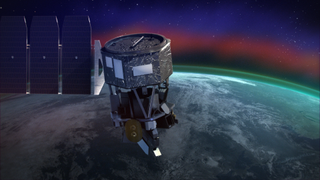NASA's Ionospheric Connection Explorer (ICON): Exploring Earth's Ionosphere

Sitting above the majority of Earth's atmosphere is a little-explored layer called the ionosphere. NASA's Ionospheric Connection Explorer (ICON) is set to become the first space-based mission to investigate this region's mysteries in depth.
ICON was slated for development in 2013, along with the complementary Global-scale Observations of the Limb and Disk (GOLD) mission, as part of NASA's Heliophysics Explorer Program. Both satellites will study the ionosphere, an important atmospheric layer stretching from around 30 to 600 miles (50 to 1,000 kilometers) above Earth's surface.
ICON is 76 inches (193 centimeters) tall with a 42-inch (106 cm) diameter — roughly the size of a large refrigerator, according to NASA. It weighs 634 lbs. (287 kg), which is about as much as a small motorcycle. The mission is operated by researchers at the University of California, Berkeley.
What is the ionosphere?
Atoms and molecules in the ionosphere are bombarded with radiation from the sun, which splits them apart into their constituent particles, such as protons and electrons. This process is called ionization — hence the name of the layer.
Many satellites orbit our planet within the ionosphere, as does the International Space Station. This is also the region where beautiful glowing auroras are created when charged particles from the sun interact with Earth's magnetic field.
The ionosphere is constantly in flux. During the day, the sun's energy continually severs the connections between protons and electrons. But as Earth turns and the ionosphere enters nighttime, the particles have the opportunity to slowly recombine, creating an ever-changing and turbulent region. The sun regularly produces enormous explosions of radiation and charged particles known as solar storms, and these also drive instabilities in the ionosphere.
For many years, scientists thought the sun caused most of the changes in the ionosphere, but more recent work has shown that a great deal of variability occurs in this region, even when the sun is relatively quiet and not producing storms. Terrestrial weather patterns also appear to be involved in the ionosphere's fluctuations, meaning it is caught in a "tug-of-war between Earth's atmosphere and the space environment," as described on UC Berkeley's ICON website.
The key to communication
The ionosphere is important for communication on our planet. Radio waves used for navigation are often sent through the atmosphere, and Global Positioning System (GPS) satellites, which fly high above the ionosphere, have to send their signals directly through this turbulent layer. Patches of ionized material "can act like bubbles in a lens or scratches in a mirror, distorting the signal, sometimes to the point of unintelligibility or unusability," according to UC Berkeley.
That is why ICON will monitor a region between 60 and 300 miles (100 and 500 km) above our world, constantly watching to see how the ionosphere changes in response to both Earth's atmosphere and incoming radiation. It will do so using a suite of four instruments.
Built by the Naval Research Laboratory in Washington, D.C., the Michelson Interferometer for Global High-resolution Thermospheric Imaging (MIGHTI) will look at particles in the bottom-most region of the ionosphere, monitoring how they interact with Earth-based weather systems.
The Ion Velocity Meter (IVM), built by the University of Texas at Dallas, will measure the speed of charged particles such as protons and electrons, watching how they move in response to the ionospheric winds.
And finally, the Extreme Ultra-Violet (EUV) instrument and Far Ultra-Violet (FUV) instrument, both built by UC Berkeley, will capture images of the ionosphere that scientists can study to investigate changes in its daily cycles.
A delayed start
ICON was originally scheduled to launch at the end of 2017 on a Pegasus XL rocket, a vehicle that is dropped from an airplane at around 40,000 feet and then ignites its engines to carry small satellites into space. But problems with Pegasus XL have caused consistent delays. The mission was most recently set to launch on Nov. 7, 2018, but the attempt was called off when engineers noticed a slight but undisclosed problem with the rocket.
"NASA and Northrop Grumman are continuing to investigate the off-nominal data observed during the Pegasus XL rocket's Nov. 7 launch attempt for the agency's Ionospheric Connection Explorer, or ICON, mission. The next launch attempt will be evaluated once the investigation is complete. The ICON spacecraft remains healthy," NASA said in a blog post after the attempt.
Join our Space Forums to keep talking space on the latest missions, night sky and more! And if you have a news tip, correction or comment, let us know at: community@space.com.
Get the Space.com Newsletter
Breaking space news, the latest updates on rocket launches, skywatching events and more!

Adam Mann is a journalist specializing in astronomy and physics stories. His work has appeared in the New York Times, New Yorker, Wall Street Journal, Wired, Nature, Science, and many other places. He lives in Oakland, California, where he enjoys riding his bike. Follow him on Twitter @adamspacemann or visit his website at https://www.adamspacemann.com/.
